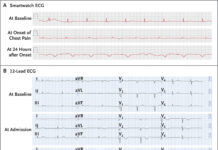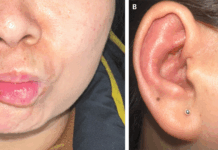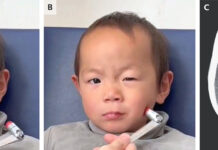11-month old presented to the ER with a worsening cough and dysphagia caused by the ingestion of a button battery
An 11-month-old girl who had been healthy up until then came to the ER with a 2-week history of coughing and dysphagia that got worse. While breathing ambient air, her heart rate was 168 beats per minute, her respiratory rate was 33 breaths per minute, and her oxygen saturation was 100%. A physical examination revealed that the patient was in severe distress. Wheezing and irregular breathing were seen. A foreign body with a “halo” or “double-ring” indication in the cervical esophagus was discovered on a chest radiograph (Panel A). This finding helps distinguish button batteries from pennies. Peripheral deterioration of the button battery was also noticed (Panel A, arrow). An immediate upper endoscopy was carried out.
After the battery was taken out, there was no visible bleeding or mucosal injuries. Approximately 10 hours after the procedure, torrential hematemesis and hemorrhagic shock were noted. An intraoperative angiography showed a fistula between the dilated esophagus and the left common carotid artery, but no source of bleeding was initially found during the emergency surgical exploration (Panel B, arrow). Hemostasis was attained after the artery was clamped. Button batteries that have been swallowed or inhaled should be immediately identified and removed due to the potential for tissue necrosis, perforation, and the formation of fistulas. The patient was discharged home 32 days following the original operation, with no neurologic or functional abnormalities.
Ingestion of batteries – a long-recognised health hazard for children
Batteries have long been known to pose a health risk for children if ingested. The National Poison Data System and the NBIH have been gathering voluntary reporting data since the 1980s, and this data has shown numerous significant trends in the epidemiology of ingestion of batteries by children. Over the past 30 years, the rate of battery ingestion in children (per million population) has remained stable. However, data from the National Electronic Injury Surveillance System indicates that the number of ED visits for battery-related injuries doubled between 1990 and 2009.
What’s more worrisome is that the incidence of serious complications and death from BBI has nearly tripled. This emergence of increasing BBI-associated morbidity and mortality emerged in the mid-1990s and temporally coincides with a change in battery production toward larger-diameter, higher-voltage lithium cells. Larger-diameter lithium batteries have become more common in homes, and as a result, they have become a larger portion of ingested batteries.
More than 90% of adverse outcomes from BBI in children between 2000 and 2009 were related to more than 20-mm diameter lithium batteries
The traditional, previously standard, less than 15-mm alkaline BB is less likely to become impacted in the pediatric esophagus than the 20–25 mm diameter lithium BB due to its size. The majority of serious outcomes occur in young children under the age of 5. Young children are more prone to oral objects in their environment, and foreign body impaction is more likely in them because to their smaller esophageal width. Over 50% of BBI-related adverse outcomes happen as a result of unintentional ingestions, which means that recognition and diagnosis are probably delayed in these cases.
However, as a result of public education and advocacy campaigns, the medical and parent communities are now considerably more aware of the elevated risk linked to lithium-ion batteries. Increased resources to address these dangers have been made available, and it is believed that this will lead to a reduction in the frequency of severe events. In addition, toy companies have mostly complied with requests to protect the battery compartments in their products, and battery companies have modified the packaging of their products to make the batteries more childproof.
Source:




